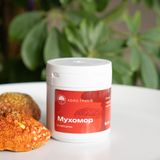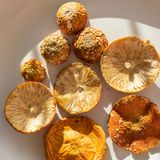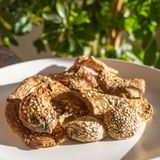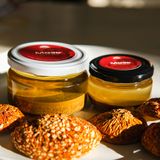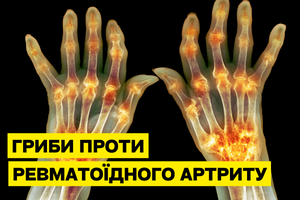Red fly agaric for pain suppression. Mechanisms of action.
Research on the effects of red fly agaric (Amanita muscaria) on inflammatory processes and pain is of considerable interest. Today, it is being conducted in scientific institutions around the world, and interest is growing every day.
The first study we want to introduce you to was conducted in Brazil. The Department of Biochemistry and Molecular Biology, the Laboratory of Neurobiology of Pain and Inflammation, the Department of Physiological Sciences and a number of other Federal Universities of the country were involved in its implementation, and the results of the study were published in the journal "International Journal of Biological Macromolecules" in 2013.
The main objective of the study was to evaluate the possible anti-inflammatory and analgesic effects of red fly agaric polysaccharides. For this purpose, two main types of polysaccharides were isolated:
- Fucomannoglucan: a polysaccharide consisting of fucose, mannose and galactose, which has the ability to modulate the body's immune response.
- β-d-glucan: a polysaccharide that has immunomodulatory properties and can help improve the immune response.
The studies were conducted on mice, and the results and time were recorded and analyzed using tests and software.
The results of this study showed that red fly agaric has analgesic and anti-inflammatory effects:
- Reduction of neurogenic pain (early phase) by 64%
- Reduction of inflammatory pain (late phase) by 91%
- Reduction of inflammatory processes in the body by reducing the release of pro-inflammatory mediators such as cytokines (peptides and proteins that play an important role in regulating the immune system and inflammatory processes).
The results of this study showed that the polysaccharides isolated from red fly agaric affect signaling pathways in the body, which allows for effective pain reduction.
The next study, published in the journal "Frontiers in Pharmacology" in April 2023, was conducted by the Nanotechnology Research Center of the National Research Council of Canada and the Neuroscience and Mental Health Institute of the University of Alberta, and aimed to evaluate the effect of red fly agaric extract on neurogenic and inflammatory pain.
It was found that when red fly agaric is used to reduce pain and inflammation, several important anti-inflammatory processes occur in the body:
- Activation of macrophages and cytokine production:
- Macrophages are immune cells that engulf and destroy microbes, harmful cells, and other harmful particles.
- Pro-inflammatory cytokines are signaling molecules that are released by immune cells and regulate the inflammatory response.
- dsRNA (double-stranded RNA) activates macrophages, which leads to the production of pro-inflammatory cytokines.
Red fly agaric enhances the production of anti-inflammatory cytokines, which help the body fight inflammation.
- Effect on GABA receptors:
- Muscimol is an agonist of GABA receptors, which are the main inhibitory receptors in the central nervous system.
Stimulation of GABA receptors reduces neuronal excitation, which leads to a decrease in pain signals and a decrease in inflammation.
- Immunomodulatory properties of polysaccharides:
- Red fly agaric polysaccharides stimulate the immune system by increasing the activity of natural killer (NK) cells and macrophages.
This helps to strengthen the immune response and reduce inflammation.
- Antioxidant activity:
- Red fly agaric contains antioxidants that reduce oxidative stress associated with inflammation.
Antioxidants protect cells from damage caused by free radicals, which reduces the inflammatory response.
- Effect on glutamate receptors:
- Ibotenic acid acts on glutamate receptors, which are the main excitatory receptors in the central nervous system.
This can alter the transmission of pain and inflammation signals, helping to reduce their intensity.
- Regulation of the level of interleukins and other mediators of inflammation:
- Interleukins (IL-1β, IL-6) and tumor necrosis factor alpha (TNF-α) are important mediators of inflammation.
Red fly agaric makes it difficult for them to be produced, which modulates the immune response to infection and damage, helping the body fight inflammation.
The results of this study demonstrate that red fly agaric can:
- Fight against excessive activation of the immune system.
- Stimulate the production of anti-inflammatory cytokines.
- Affect the receptors of the central nervous system.
- Reduce oxidative stress.
These processes help to reduce inflammation, relieve pain, and improve overall well-being.
Summarizing the results of both studies, we have confirmation that red fly agaric can effectively inhibit both neurogenic and inflammatory pain, has a bidirectional effect on the immune system: reducing inflammation by inhibiting pro-inflammatory cytokines and increasing the anti-inflammatory response, which makes it promising for wide use as an alternative analgesic for safe health improvement.
So, if you have inflammatory diseases that are accompanied by pain, pay attention to red fly agaric, visit our store and start improving your life today!
For each client individually, we draw up instructions according to his indicators and requests
Monthly rate:
- Course for beginners Fly agaric whole/ground 50g+jewelry scales - 39$
- Fly agaric whole 50 g - 31$
- Fly agaric 60 capsules - 27$
- Fly agaric for 3 months 180 capsules - 57$
Read other articles on the topic of fly agaric:
- The chemistry of fly agaric and how it affects humans.
- What is microdosing?
- The effect of the mushroom (Amanita muscaria) on stress, anxiety and quality of life in people with chronic fatigue syndrome
Contact us:






